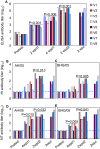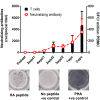Immunogenicity and protective efficacy of a live attenuated H5N1 vaccine in nonhuman primates
- PMID: 19412338
- PMCID: PMC2669169
- DOI: 10.1371/journal.ppat.1000409
Immunogenicity and protective efficacy of a live attenuated H5N1 vaccine in nonhuman primates
Abstract
The continued spread of highly pathogenic H5N1 influenza viruses among poultry and wild birds, together with the emergence of drug-resistant variants and the possibility of human-to-human transmission, has spurred attempts to develop an effective vaccine. Inactivated subvirion or whole-virion H5N1 vaccines have shown promising immunogenicity in clinical trials, but their ability to elicit protective immunity in unprimed human populations remains unknown. A cold-adapted, live attenuated vaccine with the hemagglutinin (HA) and neuraminidase (NA) genes of an H5N1 virus A/VN/1203/2004 (clade 1) was protective against the pulmonary replication of homologous and heterologous wild-type H5N1 viruses in mice and ferrets. In this study, we used reverse genetics to produce a cold-adapted, live attenuated H5N1 vaccine (AH/AAca) that contains HA and NA genes from a recent H5N1 isolate, A/Anhui/2/05 virus (AH/05) (clade 2.3), and the backbone of the cold-adapted influenza H2N2 A/AnnArbor/6/60 virus (AAca). AH/AAca was attenuated in chickens, mice, and monkeys, and it induced robust neutralizing antibody responses as well as HA-specific CD4+ T cell immune responses in rhesus macaques immunized twice intranasally. Importantly, the vaccinated macaques were fully protected from challenge with either the homologous AH/05 virus or a heterologous H5N1 virus, A/bar-headed goose/Qinghai/3/05 (BHG/05; clade 2.2). These results demonstrate for the first time that a cold-adapted H5N1 vaccine can elicit protective immunity against highly pathogenic H5N1 virus infection in a nonhuman primate model and provide a compelling argument for further testing of double immunization with live attenuated H5N1 vaccines in human trials.
Conflict of interest statement
The authors have declared that no competing interests exist.
Figures






References
-
- Shortridge KF, Zhou NN, Guan Y, Gao P, Ito T, et al. Characterization of avian H5N1 influenza viruses from poultry in Hong Kong. Virology. 1998;252:331–342. - PubMed
-
- Claas EC, Osterhaus AD, van Beek R, De Jong JC, Rimmelzwaan GF, et al. Human influenza A H5N1 virus related to a highly pathogenic avian influenza virus. Lancet. 1998;351:472–477. - PubMed
-
- Subbarao K, Klimov A, Katz J, Regnery H, Lim W, et al. Characterization of an avian influenza A (H5N1) virus isolated from a child with a fatal respiratory illness. Science. 1998;279:393–396. - PubMed
-
- de Jong MD, Tran TT, Truong HK, Vo MH, Smith GJ, et al. Oseltamivir resistance during treatment of influenza A (H5N1) infection. N Engl J Med. 2005;353:2667–2672. - PubMed
Publication types
MeSH terms
Substances
Grants and funding
LinkOut - more resources
Full Text Sources
Medical
Research Materials

